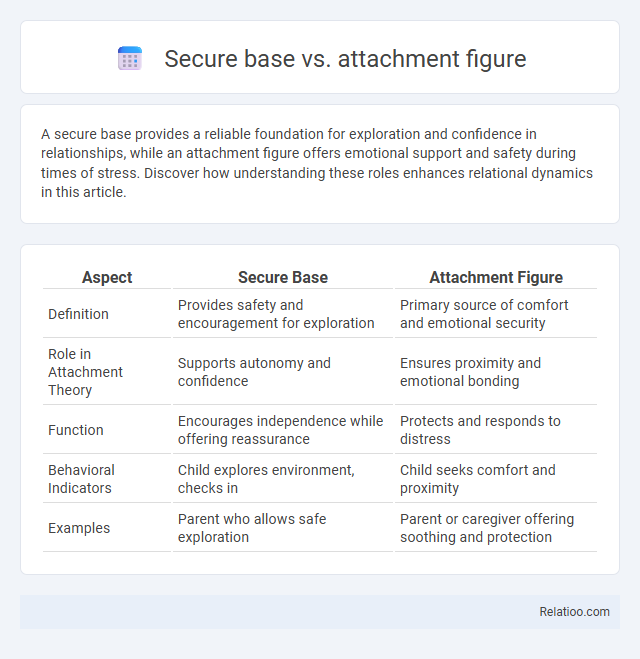A secure base provides a reliable foundation for exploration and confidence in relationships, while an attachment figure offers emotional support and safety during times of stress. Discover how understanding these roles enhances relational dynamics in this article.
Table of Comparison
| Aspect | Secure Base | Attachment Figure |
|---|---|---|
| Definition | Provides safety and encouragement for exploration | Primary source of comfort and emotional security |
| Role in Attachment Theory | Supports autonomy and confidence | Ensures proximity and emotional bonding |
| Function | Encourages independence while offering reassurance | Protects and responds to distress |
| Behavioral Indicators | Child explores environment, checks in | Child seeks comfort and proximity |
| Examples | Parent who allows safe exploration | Parent or caregiver offering soothing and protection |
Introduction to Secure Base and Attachment Figure
A secure base is a foundational concept in attachment theory, referring to a caregiver who provides a reliable source of safety and support, enabling a child to explore the world confidently. An attachment figure is the specific person, often a parent or primary caregiver, with whom the child forms a deep emotional bond critical for healthy social and emotional development. Your understanding of the distinction between secure base and attachment figure can enhance your ability to foster strong, supportive relationships that promote resilience and well-being.
Defining Secure Base in Attachment Theory
A secure base in attachment theory refers to a caregiver's reliable presence that provides a child with safety and confidence to explore their environment. Unlike an attachment figure who serves as a general source of comfort and security, the secure base specifically enables autonomous exploration while reassuring the child's emotional stability. This concept is foundational in understanding how secure attachment supports healthy developmental outcomes by balancing closeness and independence.
What is an Attachment Figure?
An attachment figure is a person, typically a caregiver or close family member, who provides emotional security and comfort to a child during times of distress or uncertainty. This figure plays a crucial role in the development of healthy emotional regulation and social relationships by serving as a reliable source of support and protection. Your secure attachment to this figure fosters confidence and resilience, enabling you to explore the world while feeling safe and understood.
Secure Base vs Attachment Figure: Key Differences
A Secure Base provides a reliable environment that supports exploration and growth, while an Attachment Figure is the specific person--often a caregiver--who offers emotional safety and comfort. Your secure base encourages independence and resilience by being consistently available, whereas an attachment figure is the primary source of emotional bonding and protection. Understanding these distinctions helps in fostering healthy relationships and emotional development.
The Role of a Secure Base in Child Development
A secure base in child development refers to a caregiver who provides consistent emotional support, enabling the child to explore their environment confidently while knowing they can return for comfort. Unlike attachment figures who primarily offer safety and emotional bonding, a secure base actively encourages independence and learning through exploration. This dynamic fosters resilience, social competence, and cognitive growth by balancing protection with autonomy.
Functions of an Attachment Figure
An attachment figure serves as a consistent source of comfort, security, and emotional support, enabling you to explore your environment confidently while feeling safe. The primary functions include providing a secure base from which to venture out and a safe haven to return to during distress. This role differs from a general secure base by emphasizing emotional responsiveness and availability critical for healthy attachment development.
Overlapping Characteristics of Secure Bases and Attachment Figures
Secure bases and attachment figures share overlapping characteristics such as providing safety, emotional support, and a reliable presence during times of stress and exploration. Both function as sources of comfort and security, enabling individuals to confidently engage with their environment while knowing they have a dependable refuge. These shared qualities reinforce trust and emotional bonds, essential for healthy psychological development and relational stability.
Psychological Impacts of Secure Base vs Attachment Figure
A secure base provides a reliable foundation that fosters exploration and autonomy, promoting psychological resilience and self-confidence in individuals. In contrast, an attachment figure primarily offers emotional security and comfort during stress, reducing anxiety and enhancing emotional regulation. The presence of a secure base encourages adaptive coping strategies and independence, while the attachment figure ensures emotional stability and supportive bonding.
Secure Base and Attachment Figure in Adulthood
In adulthood, a secure base refers to a trusted partner or close individual who provides emotional support and stability, enabling personal exploration and growth. An attachment figure, often a romantic partner or close friend, serves as a source of comfort and security during times of stress and uncertainty. Both roles are crucial for emotional regulation, fostering resilience, and maintaining healthy interpersonal relationships.
Conclusion: Integrating Concepts for Healthy Relationships
Secure base, attachment figure, and safe haven are interconnected concepts essential for fostering healthy relationships by promoting emotional security and exploration. An attachment figure provides consistent support and comfort, while a secure base allows individuals to confidently engage with the world knowing they have reliable emotional grounding. Integrating these concepts enhances relational resilience, trust, and personal growth within close bonds.

Infographic: Secure base vs Attachment figure
 relatioo.com
relatioo.com